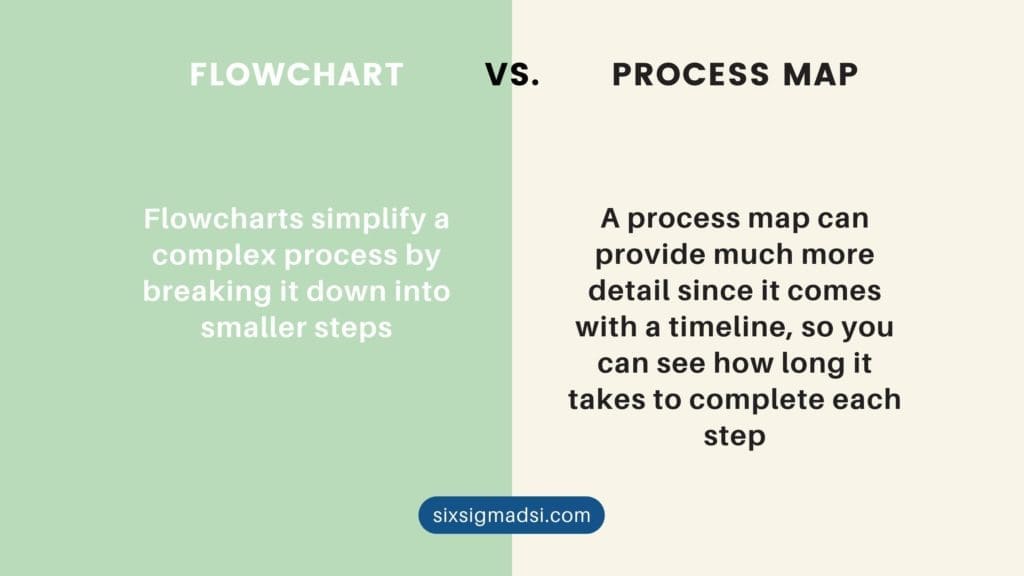Table of contents
Process Mapping vs. Flowchart: Key Differences
It is difficult to explore a huge amount of data in order to understand business processes and standards. Visual content is a great way to help with this. Flowcharts are essential when it comes to explaining a business process-performance maturity procedure in a way that is easily understood. Flowcharts are now an integral part of nearly all businesses around the world. The two are very closely related, and millions of people search for the debate between a flowchart vs a Process Map. You will learn more about a flow chart vs a process map if you read the discussion below.
What is a Flowchart?
A flowchart is an illustration of boxes or shapes connected by arrows. Each box contains text representing a particular step in a workflow or process. The flowchart is intended to show the workflow or process in sequential order. Multiple boxes are connected by arrows, and multiple arrows branch off from each box to represent variables. A flow chart is usually drawn from the top and works its way down. However, this isn’t always required.
The main focus of a flowchart is to maintain a sequential order while presenting a step-by-step workflow of process-performance. The benefit of using a flowchart lies in the ability to clearly visualize each step. This diagram simplifies complex processes. Visual components make it easier to highlight mistakes and fix them quickly. Flowcharts use different symbols (diamond, oval, rectangle, etc.) To show the type and flow of the steps, arrows are used. Both technical and non-technical people can benefit from these diagrams.
The Benefits of a Flowchart
The flowchart provides a visual representation of the different steps in a workflow. It can help to make it easier to comprehend large amounts of data and to see connections. These are easy to make. Visualizing the steps and connections allows you to easily identify mistakes. A flowchart simplifies analysis and helps to get a better picture of the whole.

How to Create a Flowchart
You must first define scope and boundaries, such as the start and finish point, inputs and outputs, criteria, and conditions. Next, you will need to identify the decisions and steps in the process. This includes the events and actions that happen and the choices and outcomes which affect the process. Then, order the decisions and steps in a logical sequence. Draw symbols, labels, and arrows for each decision and step. Finalize the flowchart by reviewing and refining it to ensure that it is accurate, complete, and consistent.
It is important to understand why and who you will be creating a flowchart for. You may want to standardize a procedure to improve its efficiency, communicate a complicated process, or try to simplify a complex business process. Knowing the purpose of the flowchart will help you choose the right template and decide whether you want it to be informal or formal.
You can either use a template from an online resource or draw one yourself on a piece of chalkboard, paper, etc. It is important to choose the type of shapes that you will use. You can use a single uniform shape or a variety of shapes that each represent something different. Here are some common shapes and their meanings:
- The terminal or oval shape is used to indicate the beginning and end of a flowchart.
- The rectangle is usually the shape that you see most frequently on flowcharts.
It usually refers to an action, task, or operation. - Diamond – This is a shape that usually represents a decision. The text within the diamond will generally pose a question.
The arrows will take off in different directions if you ask a yes/no question.
Depending on the answer. - Circle – Circles can be used in situations where an arrow is not appropriate to connect two sections of the chart.
What is a Process Map?
A process map provides a clear and sequential representation of all the inputs, actions, and outputs involved in a particular process. You can benefit from a process map in several ways. You can easily understand any process and identify where improvements are needed. It helps improve communication by breaking down a complex process-performance maturity into smaller steps.
A process map can also be used to document and standardize workflows. It also allows you to better plan and organize your future projects. You can also visualize each stage of the process, ensuring that you have all the resources you need to reach your goal.
The Benefits of a Process Map
Process Mapping has many benefits. A process map can help improve one’s understanding and provide an easy way to identify where improvements could be made. The process map breaks down the steps to make it easier for others and improves communication in a team. A process map can also be used to document a process and serve as a guide.
How to Create a Process Map
You will need to first identify the process that needs to be visualized before you can create a process mapping. Then, you will need to determine the number of activities involved, the level of detail, and the starting/ending point for the map. You will then sequence the steps using the correct shapes. You should then go back over the map to ensure that everyone is on the same page.
You must define the scope and goals of the process. Then, you need to identify the activities in the process. Arrange the activities in a horizontal layout or vertical layout. Draw shapes, colors, and lines for each role and activity. Finally, review and refine your process map. Consider the outcome and goal of the process. Who are the stakeholders and customers? What tasks and functions do they perform in the processes? Who is responsible or involved in it all? Use different shapes and colors to represent the different types of roles and activities. Lines can also be used to indicate relationships and the flow of the process. You should also eliminate any redundant or overlapping roles or activities.
Process Map vs Flow Chart: Key Differences
Many people believe that process maps vs flowcharts can be interchanged in process-performance maturity, but it’s not true. They are similar, but there is one notable difference. Process maps are more detailed and contain a timeline than flowcharts.
It is common to believe that “process map” or “flowchart”, can be used interchangeably. It’s not true. They share many common traits, but they also have some distinct differences.
Flowchart simplify a complex process by breaking it down into smaller steps, and a process map, on the other hand, can provide much more detail. A process map comes with a timeline, so you can see how long it takes to complete each step.
Process maps vs flowcharts can be used for the same audience, but you should use them when you want a more detailed outline. If you need to show a timeline that defines the time frame for each step in the process maturity, then a process chart is the best option. In this case, a flowchart is not suitable as it contains no timeline.




















